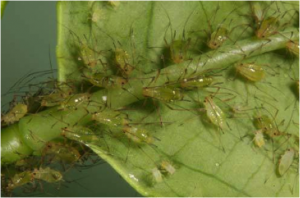From the Blueberry Bulletin
Cesar Rodriguez-Saona, Extension Specialist in Blueberry Entomology
Dean Polk, IPM Agent – Fruit
Gene Rizio, IPM Program Associate – Fruit
Aphids: About 32% of shoot samples are positive for aphid infestation. As was the case last week, these are single aphids. They have not started to multiply into colonies. At this early stage searches should be done on the lowest shoot terminals. This is also where worm larvae are more likely to show up.
Biology and Life Cycle. Aphids are soft bodied, slow moving insects (see picture). The adults are on average about 2 mm long, light to dark green. They have piercing-sucking mouthparts, and two siphunculi (cornicles) that protrude to the rear from the 6th abdominal segment. Nymphs resemble the adults, but are smaller and wingless.
There are four principal species of aphids that attack blueberries. These include: the blueberry aphid, Illinoia pepperi (present in Michigan), I. azaleae (present in New Jersey), the (western) blueberry aphid, Ericaphis fimbriata, and the green peach aphid, Myzus persicae. Aphids overwinter as eggs, which are deposited on stems and small shoots. Eggs hatch in the spring. At this time of the year, immatures feed on tender new growth, usually on the undersides of leaves at the top or bottom of blueberry bushes. Males and egg-laying females are produced in the fall. There are several generations per growing season.
Damage. Aphids suck sap from tender growth and new shoots, especially from developing terminal foliage. Under heavy populations, a sooty mold can develop on the honey dew secreted by the aphids. This is usually of minor importance in blueberries, since growers seldom allow aphid populations to build up to high densities. Of more importance is the fact that many aphids function as disease vectors. In blueberries aphids can transmit blueberry scorch virus (BlScV) and its several strains.
Monitoring and Control. Since disease transmission is a main concern in commercial blueberry farms, only very low aphid populations is tolerated, especially if BlScV is a known problem. Aphids may be present while bushes are in bloom, but populations don’t start to build up until after bloom. Monitoring should begin as soon as bees are removed and continue through at least the first picking. Sampling should be biased in new terminal growth, and data recorded as the percent of terminals infested with aphid colonies. Where disease transmission is an issue, a colony should be defined as a minimum of 1-2 aphids, either nymphs or adults. Treatment is justified if greater than 10% of terminals are infested with live aphids. The neonicotinoids Assail, Actara, and Imidacloprid (e.g. Admire Pro) provide good aphid control. Lady beetles, lacewings, syrphid flies, and other biological controls are often abundant in blueberry farms at this time of the year and may help maintain aphid populations at low levels.
Plum Curculio (PC): About 7% of beating tray samples have been positive for PC adults. This is an increase since last week. As soon as pollination is complete, growers should have bees removed and treatments should be applied. PC should not be ignored since it can result in larval infested fruit. All farm locations have at least low levels of this critical pest.
Leps. and Leafroller Larvae: No larvae have been seen in beating tray samples. However, 12% of shoot samples have been positive. None of these have been over the 5% shoots infested treatment level. The first generation Redbanded leafroller adult flight is now just beyond the peak in Atlantic Co. This pest is rarely a problem in most areas. If you have concerns, then look for small green larvae that may be visible in the tips of rolled up leaves in the lower developing shoots. You DO NOT NEED TO TREAT unless young larvae are present.
Thrips: Thrips have recently been seen in sticky traps at low numbers, however sampling of flowers has only shown 1 insect across many farms. Thrips are not a target unless present in significant numbers in the flowers. In previous seasons we have seen very high trap levels without any significant flower infestation.
Based on our “Thrips Activity Predictions” (http://benedick.rutgers.edu/Blueberryweather/ddcalc2.php), so far thrips have accumulated a total of 304.85 degree-days. Based on our multi-year experiments, thrips require approx. 690 degree-days to reach 10% activity. Thus, no treatment for thrips is recommended at this time.
| PEST/DISEASE/CULTURE | MAY13 – 20 BLOOM | MAY 20 – 27 BLOOM |
| Moth Larvae – Leafrollers, Spanworms |
Scout flower clusters for “worm” activity. Treat w/ Bt products or Intrepid/Confirm if over 1 larva per 100 flower clusters. |
Scout flower clusters for “worm” activity. Treat w/ Bt products or Intrepid/Confirm if over 1 larva per 100 flower clusters. |
| ThripsDelegate (Dusk), Entrust (Dusk).
These insecticides are highly toxic to bees. Thus, use them when bees are not activity (dusk) to minimize exposure. |
Monitor using white sticky traps and by sampling thrips on flowers (beating tray samples). There is no economic injury level for this insect. However in past seasons our “concern level” has been about 7% of flowers infested with 1 or more thrips, or roughly 70 thrips per 100 clusters (about 1,000 flowers). |
Continue to monitor |
Blueberry Insect Trap Counts – Atlantic County
| Week Ending | CBFW | RBLR | OBLR | SNLH | ORB | BBM | BMSB |
| 4/13 | 116 | ||||||
| 4/20 | 120 | ||||||
| 4/27 | 100 | ||||||
| 5/4 | 0 | 72 | |||||
| 5/11 | 0.01 | 28 |
Blueberry Insect Trap Counts – Burlington County
| Week Ending | CBFW | RBLR | OBLR | SNLH | ORB | BBM | BMSB |
| 4/13 | 71 | ||||||
| 4/20 | 44 | ||||||
| 4/27 | 38 | ||||||
| 5/4 | 0 | 26 | |||||
| 5/11 | 0 | 9 |


